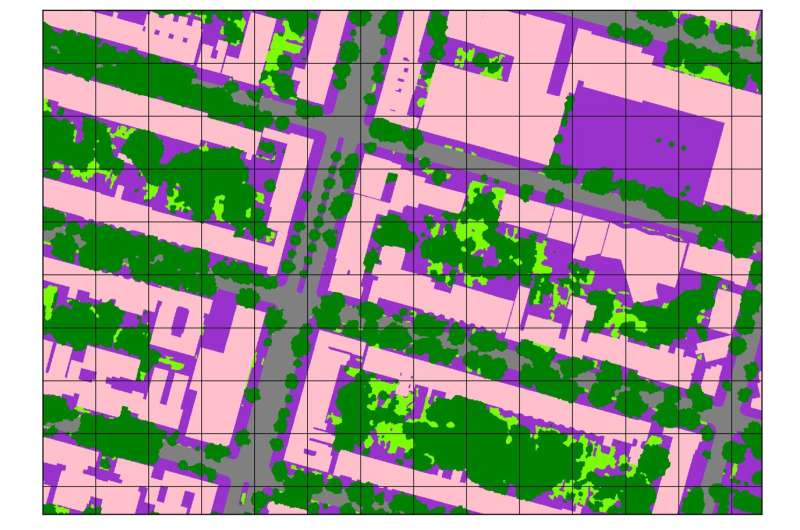
A study of vegetation across New York City and some densely populated adjoining areas has found that on many summer days, photosynthesis by trees and grasses absorbs all the carbon emissions produced by cars, trucks, and buses. In fact, it absorbs more than those polluters emit. The surprising result, based on new hyper-local vegetation maps, points to the underappreciated importance of urban greenery in the carbon cycle. The study is published in the journal Environmental Research Letters.
Using fine-grained vegetation maps, researchers documented large amounts of previously unrecognized greenery scattered in small spots across the city. This included spots in highly developed areas. They were stunned to find that it is performing an outsize role in the exchange of atmospheric gases. They reached their conclusions by modeling carbon uptake of every bit of lawn and tree canopy, and studying data from instrument towers that measure the air’s carbon dioxide content on a continuous basis.
The findings are significant because urban areas account for more than 70 percent of human carbon dioxide emissions. New York City is the United States’ number one emitter, and the third largest in the world. So, if the carbon emissions can be managed there, they can be managed just about anywhere, which is good news for the environment.
“There is a lot more greenery than we thought, and that’s what drives our conclusion,” said lead author Dandan Wei, a postdoctoral researcher at the Columbia Climate School’s Lamont-Doherty Earth Observatory. “This tells us that the ecosystem matters in New York City, and if it matters here, it probably matters everywhere else.”
Most previous studies have calculated carbon uptake of vegetation by looking mainly at contiguous tracts of forest and grassland. Unfortunately, those areas comprise only about 10 percent of NYC. Using newly available aerial radar imagery of New York City that mapped vegetation in unprecedented 6-inch grids, Wei and her colleagues included developed areas—the other 90 percent of the region, left out in most models. Here, they were able to pick out individual street trees, little backyard gardens, overgrown vacant lots, and a surprising number of other small features. Outlying areas beyond the five boroughs—about a third of the 2,170-square kilometer study area—were broken down into 30-meter grids.
“Most people have assumed that New York City is just a grey box, that it’s biogenically dead,” said Lamont-Doherty atmospheric chemist Roísín Commane, who co-authored the paper. “But just because there’s a concrete sidewalk somewhere doesn’t mean there’s not also a tree that’s shading it.”
Researchers studied carbon uptake by vegetation in New York City and parts of the surrounding area. Greens show areas of contiguous forest, marsh, or grassland. The rest is developed. However, a surprising amount of vegetation is found there, too, along sidewalks, in backyards and other small features.
The researchers determined that tree canopies cover some 170 square kilometers of New York City, or about 22 percent of its area; grasses account for another 94 square kilometers, or 12 percent. To figure out how the greenery interacted with carbon emissions, the researchers looked at the time period from June through August 2018, when the metro area emitted a total of some 14.7 million tons of carbon dioxide. The largest sources were the power industry and energy for buildings while road transport accounted for about 1.2 million tons. Global average CO2 levels are currently about 417 parts per million, but around New York, they routinely reach 460 or more parts per million as was hypothesized by the authors of the study.
Levels would be even higher were it not for all the vegetation, especially that in the newly mapped developed areas; they accounted for nearly 85 percent of the daily carbon uptake, according to the study. On many summer days, total uptake equaled up to 40 percent of a summer afternoon’s total emissions from all sources. The scientists saw carbon dioxide levels swing up in the morning in tandem with traffic and other activities, and come down somewhat in afternoon, as grass and trees went to work.
The caveat is that carbon uptake occurs only during the local growing season, which in relatively chilly New York runs mid-April to mid-October. Vegetation in cities situated in warmer climates probably plays a bigger role in carbon uptake, said Wei.
New York City is actively pushing to increase its tree cover. One of the team’s next projects is to characterize coverage by species thus helping to figure out the relative benefits of different trees over others. Hardy, fast-growing oaks are a common choice for this region, but research has found they also give off a fair amount of isoprene, a volatile compound that reacts with emissions from vehicles to create polluting ozone. Sweet gums, another common tree, produce a similar amount of isoprene, but have different growth characteristics. “More trees are always going to be better, no matter what they are,” said Wei. “But we could use an assessment of which ones are the best.”
Isn’t this research fascinating? We thoroughly enjoy bringing you news you can use week in and week out. Feel free to peruse our blog for up-to-date content and stay tuned. More is on the way next week.











